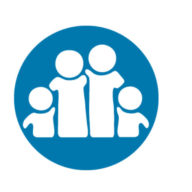Depression

What is Depression?
Depression is often called the “common cold” of mental health because, similar to a cold, almost everyone has experienced symptoms of depression—sadness, loss of pleasure and interest in previously enjoyable activities, difficulty concentrating, irritability, changes in sleeping and/or eating habits, hopelessness. When symptoms are persistent and cause a change in one’s ability to function, depression may be diagnosed.
Common Symptoms/How It Impacts Someone’s Life:
- Exhibiting a lack of motivation, interest or energy in a person’s life
- Feeling devoid of energy to take a shower, make a meal, talk with a friend, or go for a walk seems overwhelming
- Feeling that time has slowed or stopped, that the world seems grey or devoid of color and thoughts seem slow, self-critical and negative
- Missing deadlines, procrastinating or having trouble making decisions
People often realize that their behavior is not ideal and feel terrible that they are struggling to keep up with their usual responsibilities. Guilt, worry and irritability can be part of depression as well. Losing interest in work and daily activities can lead to feelings of frustration, worry about the future and guilt about tasks left undone.
Sometimes, depression symptoms include self-harm and thoughts of suicide.
What Can Depression Look Like?

In Crisis
Very anxious
Very low mood Absenteeism
Exhausted
Very poor sleep
Weight loss

Struggling
Anxious
Depressed
Tired
Poor Performance
Poor Sleep
Poor Appetite

Surviving
Worried
Nervous
Sad
Distracted
Trouble Sleeping
Withdrawn

Persevering
Fine
Calm
OK
Keeping Up
Rested
Managing

Excelling
Cheerful
Joyful
Energetic
High performance
Flow
Fully realising potential
Ways to Treat Depression:
There are many helpful treatments for depression and options for every level of care.
Universal Precautions (things you can do and plan on your own)
• Taking care of getting proper sleep and nutrition
• Minding your physical health (regular check-ups and if applicable, taking prescribed medication)
• Working out/including movement and exercise
• Spending time with friends
• Journaling
• Practicing mindfulness
• Experiencing joy, play and awe
Evidence Based Treatment Options (Reaching out to a trained professional)
• Therapy
◦ ACT
◦ CBT
◦ DBT
◦ Family Therapy
◦ Mindfulness Based Cognitive Therapy
◦ Play Therapy
All therapeutic styles will involve learning about:
◦ the way our brains operate (the stress response system, expected cognitive impairments when we are under stress),
◦ the symptoms of depression and ways to address and shift them,
◦ the way that thoughts, feelings and behaviors are linked and influence each other.
◦ Most therapeutic styles involve exploring without judgment one’s feelings, beliefs, thoughts, and habits in an effort to
reframe /expand awareness /experiment with ideas.
This allows the thoughts, feelings and behaviors to change and influence each other in new ways.
Therapy also involves learning about and practicing strategies and coping habits that support wellbeing.
• Medications –there are many medication options that have shown some benefit in reducing depression symptoms.
If you or someone you know is in Crisis and unable to perform daily activities:
Symptoms may be or become overwhelming and prevent a person from engaging many of the above interventions. People who are in crisis may require a more intensive treatment plan. When this is the case, call a professional as soon as possible. What happens next might include:
• Health and Safety Assessment (HSA)—people experiencing a crisis may benefit from a structured interview with a mental health clinician to assess the threats to their wellbeing and provide recommendations regarding seeking treatment.
• Partial Hospitalization Programs (PHPs)
• Intensive Outpatient Programs (IOPs)
If you or someone you know is in Danger of harm (Immediately call 9-1-1 or go to a crisis-trained organization)
• Emergency Room Hospitalization. Dial 9-1-1 or proceed to your nearest emergency room if you or someone you are with is in imminent danger of harm.
Resources:
- Eisenberg Family Depression Center at U of Michigan: https://depressioncenter.org/outreach-education/community-education/depression-toolkit/not-feeling-well/learn-about-it/learn#signs-and-symptoms
- Mayo Clinic: https://www.mayoclinic.org/diseases-conditions/depression/symptoms-causes/syc-20356007

